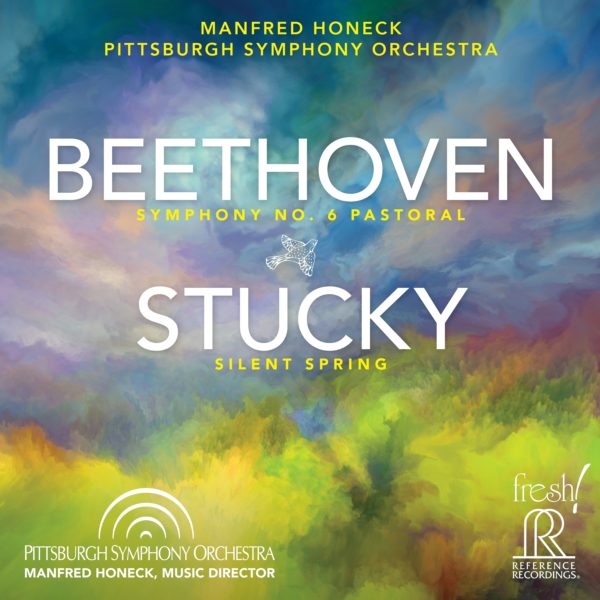
On their new release from Reference Recordings, Manfred Honeck and the Pittsburgh Symphony Orchestra perform Beethoven’s Symphony No. 6 “Pastoral” and Steven Stucky’s Silent Spring.
In typical fashion, Honeck re-interprets a warhorse in ways that are at once noticeable (some might say shocking) but also satisfying. Not many conductors have the street cred to reimagine masterpieces in the standard repertoire. But Honeck, an Austrian and former violinist with the Vienna Philharmonic, knows his stuff. Every one of Honeck’s recordings of major works in the standard repertoire is unique. I mean, what’s the point of recording another well-played version of Beethoven’s Third, Fifth, Sixth, Seventh or Ninth, or Brahms’ Fourth or Tchaikovsky’s Fourth if a conductor can’t offer something different and compelling?
I’m sure all conductors think carefully about the works they perform, even if they have performed them many times. With Honeck, however, one gets insight into how he thinks about the compositions because he writes the liner notes and describes in detail (with measure numbers and times on the recording) where he has the musicians in the orchestra play what. And, as he is wont to do with other interpretations, Honeck imposes his own ideas on specific parts of the pieces. But his ideas are informed, in the present case, by Beethoven’s own markings in the score and notes in his sketchbooks, as well as historical facts about Beethoven and comments from his contemporaries.
Of course, the listener — or reviewer — may like or dislike what one may describe as Honeck meddling with a master’s score. In reviews of previous Honeck recordings with the PSO, I have expressed my likes and dislikes, but they were based on my own personal preferences and nothing more.
I mention all of this because in this recording of Beethoven’s Sixth Symphony, Honeck makes some pretty obvious changes, more than just playing around with dynamics, which he regularly does in his interpretations and which I almost always appreciate. There are at least two conspicuous instances in this recording. One occurs in two places — in the first and third movements — where Honeck amplifies the bird calls played by the flutes by adding the piccolo. Perhaps more startling is the change in the third movement, which Beethoven titled “Merry assembly of country folk.” About 53 seconds into the movement, Honeck asks the “musicians to stamp along with their feet exactly on the repeated sforzati(emphasized beats) with the goal to acoustically imitate the fervor of the peasants” as they dance. This might simply go too far for some critics. Listeners can judge for themselves.
The differences in this recording are noticeable right from the start. The first movement, which Beethoven titled “Awakening of cheerful feelings on arriving in the country,” moves along at a faster clip than many other recordings. This relatively faster tempo, however, conveys the excitement of the person (Beethoven) upon arriving in the country. The other movements are equally satisfying, with dynamic changes and numerous places where Honeck allows individual instruments to stand out, which one rarely hears in other recordings.
The overall effect is a lively and energetic version of Beethoven’s Sixth that perfectly captures what I think Beethoven was trying to convey. This performance of Beethoven’s Pastoral Symphony by the PSO is exciting and a must for anyone wanting to hear a fresh approach to this masterpiece. In many ways, listening to Honeck and the PSO perform Beethoven’s Pastoral Symphony is like hearing it for the first time.
On this CD, Honeck pairs the Beethoven with Silent Spring by Steven Stucky. Stucky was commissioned by the PSO to compose Silent Spring to commemorate the 50th anniversary of the publication of Silent Spring by Rachel Carson who was a Pittsburgh native. Stucky’s Silent Spring is a one-movement tone poem which consists of four sections. Stucky titled the first section, The Sea Around Us, after Carson’s first book. The titles of the second two sections — The Lost Wood and Rivers of Death — were two chapters in Silent Spring, and the title of the final section is Silent Spring.
The orchestration reflects Stucky’s rendering of Carson’s warnings about how we are destroying the natural world around us, with lots of playing in the lower registers and sharp, jagged bursts of strings. In the end, however, as Stucky writes, “like the insects and birds that Rachel Carson wrote about, one by one those ecstatic orchestral voices fall quiet. We are left with near silence.” Silent Spring certainly captures the feelings one might have about what we humans have done to our natural world.
The pairing of the Beethoven with Stucky’s piece is obvious: both deal with nature and both are semi-programmatic. But where Beethoven’s expresses feelings of joy, Stucky’s is downright dark and despairing. One laughs while the other weeps, to borrow Brahms’ description of his two overtures, Academic Festival and Tragic. Stucky himself in the liner notes uses words like “desolate,” “somber,” “scathing” and “diabolical.” But then again, times are a lot different now than they were when Beethoven derived joy and peace from walking in the woods. We have the despoliation of nature due to human-caused climate change and habitat destruction.
I’m not sure I would recommend listening to the pieces in the order in which they are presented on the CD. I, myself, would rather finish with the optimism of the Beethoven.
—Henry Schlinger, Culture Spot LA





